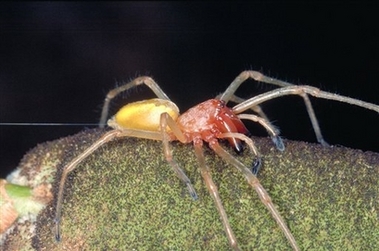VIENNA, Austria - An eight-legged invasion is giving some Austrians the
creeps. The venomous yellow sack spider, whose painful bite can cause headache
and nausea, has become the talk of the town since several people were bitten
earlier this summer.

An undated file
picture released by Oekoteam - Institut fuer Faunistik &
Tieroekologie, shows a venomous yellow sack spider. An eight-legged
invasion is giving some Austrians the creeps. The Cheiracanthium
Punctorium, known in German as a 'Dornfingerspinne,' whose painful bite
can cause headache and nausea, has become the talk of the town since
several people were bitten earlier this
summer.[AP] |
Reports of spider sightings have dominated local media, triggering hundreds
of calls to a Vienna poison hotline and prompting the government to issue a plea
for calm.
"The bites of a yellow sack spider are indeed painful but not deadly," Health
Minister Maria Rauch-Kallat said in a statement. "If you are bitten, please
don't panic and in case of discomfort immediately contact a doctor."
Underscoring the hysteria, 190 people who feared they might have been bitten
went Wendesday to the main hospital in the northwestern city of Linz. Only eight
of them turned out to have possible symptoms, doctors told Austrian state
broadcaster ORF.
Eva Reiner, a Vienna business consultant, fished a dead yellow sack spider
out of her pool this week and has not gone swimming since.
"It wasn't even alive, and it still looked evil to me," she said.
But experts are urging people to keep things in perspective.
The yellow and brown striped critter, whose Latin name is Cheiracanthium
Punctorium and is known in German as a "Dornfingerspinne," is one of 1,000
similar species found in Austria and neighboring countries including Germany,
Italy and Switzerland, said Christian Komposch of an animal ecology institute in
the southern city of Graz.
There are sightings every year, said Komposch, who blames the media for
spreading misleading information and fanning the frenzy.
Dr. Christian Baldinger, a physician in the province of Upper Austria, said
he was bitten last week while working in his garden.
"It was like a stinging nettle, but not really painful," said Baldinger, 53.
Within two days, the wound was red and infected, and a specialist told him the
symptoms could take eight to 10 weeks to subside.
Komposch advises people who think they may have been bitten to treat the
wound with hot water.
"The most important thing is: Don't panic!" he said.
For the not-so-faint at heart, the spider could bring in some cash.
Collectors are willing to fork over more than $255 for a single specimen,
according to Kurier, an Austrian daily.
But some people, such as 26-year-old bank employee Robert Schneider, do not
know what all the fuss is about.
"I think everyone is exaggerating," he said. "I'm not sure I would recognize
a yellow sack spider if I saw one."